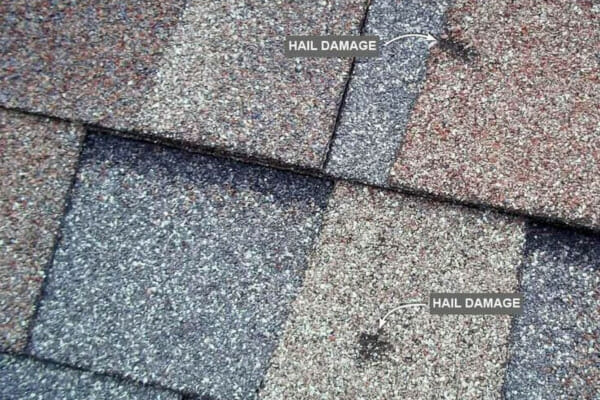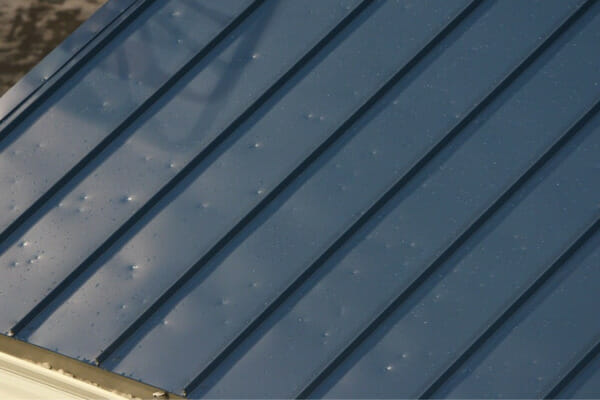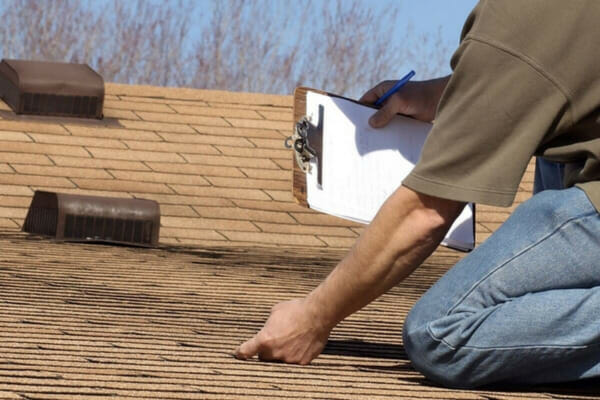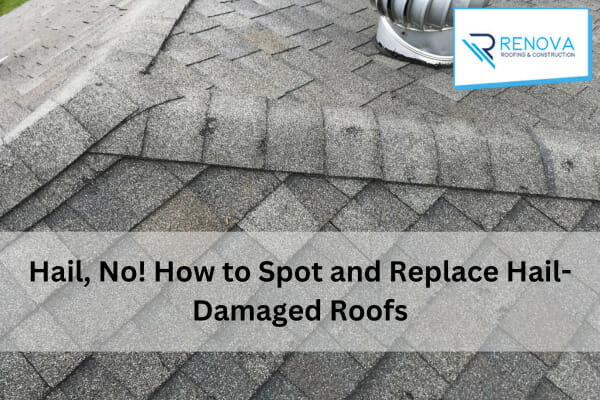Hail storms can be a homeowner’s worst nightmare, especially when it comes to the impact they have on your roof. As hailstones fall from the sky, they can cause significant damage to your property, including your roof. But what does hail damage on a roof look like, and how can you deal with it?
In this comprehensive guide put together by the team at Renova Roofing & Construction, we’ll go over how to identify hail damage to your roof. Moreover, we will talk about the repair options available and what you can do to protect your home from future hail storms. So let’s dive in!
1. Understand the Different Types of Roofing Materials
Before we discuss how to spot hail damage on your roof, it’s essential to know the different types of roofing materials. Some materials are more susceptible to hail damage than others, so understanding the strengths and weaknesses of each material will help you make informed decisions about repairs and replacements. Here are the most common types of roofing materials:
- Asphalt shingles
- Metal
- Wood shingles and shakes
- Clay and concrete tiles
Each material has its own unique characteristics, and some materials are more resistant to hail damage than others. For example, metal roofing is typically less susceptible to hail damage than asphalt shingles.
2. Signs of Hail Damage on a Roof
The primary signs of hail damage on a roof can be divided into two main categories: functional damage and cosmetic damage.
Functional Damage
Functional hail damage refers to any damage that affects the integrity and longevity of the roof. Some common signs of functional hail damage include:
- Dents, dings, or cracks on shingles
- Fractured or broken shingles
- Loss of protective granules on shingles
Cosmetic Damage
Cosmetic hail damage refers to any damage that does not significantly impact the roof’s ability to perform its primary function. Some examples of cosmetic hail damage are:
- Small dents or dings on metal roofs
- Discoloration or staining on shingles
- Minor marks or scuffs on other roof components
Keep in mind that the severity of hail damage depends on several factors, including the size and density of hailstones, the type of roofing material used, the age and condition of the roof, and the angle and speed at which hailstones fall.
3. How to Identify Hail Damage on Different Roofing Materials
Each roofing material will show different signs of hail damage. Let’s take a closer look at each one:
Asphalt Shingles
Asphalt shingles are the most common roofing material and are especially prone to hail damage. Some signs of hail damage on asphalt shingles include:
- Dents or dings on the shingle surface
- Loss of granules, exposing the underlying asphalt
- Cracks or fractures in the shingle

Metal Roofing
Metal roofing is generally more resistant to hail damage than other roofing materials. However, large hailstones or high-velocity impacts can still cause damage. Signs of hail damage on metal roofs include:
- Dents or dings on the metal panels
- Scratches or scuffs on the metal surface
- Chipping or peeling paint

Wood Shingles and Shakes
Wood shingles and shakes can also sustain hail damage. Some signs to look for include:
- Cracks or splits in the wood
- Holes or punctures from hailstones
- Discoloration or staining
Clay and Concrete Tiles
Clay and concrete tiles are more durable than other roofing materials, but they can still be damaged by hail. Signs of hail damage on clay or concrete tiles include:
- Cracks or chips in the tile
- Broken or missing tiles
- Discoloration or staining
4. How to Spot Hail Damage from the Ground
While it’s essential to inspect your roof for signs of hail damage, you can also look for some indications from the ground. These signs can help you determine if you need a professional inspection and possible hail damage roof repair. Here are a few things to check:
- Dented gutters, downspouts, or gutter screens
- Damage to siding and window casings
- Dents or dings on air conditioners, outdoor furniture, or other items
- Chipped paint or marks on decks, painted wood, or other surfaces
Remember, these signs don’t necessarily mean your roof has sustained significant hail damage, but they can indicate the need for further inspection.
5. The Hail Damage Roof Inspection Process
If you suspect that your roof has sustained hail damage, it’s essential to have it inspected by a professional. A qualified roofing contractor can assess the damage and determine whether repairs or replacements are necessary. Here’s what you can expect during a hail-damage roof inspection:
- Visual Inspection: The roofing contractor will visually inspect your roof for signs of hail damage. This includes looking for dents, dings, cracks, and missing granules on shingles, as well as damage to other roof components like vents, flashing, and gutters.
- Documentation: The roofing contractor will document any damage they find, including taking photos and measurements. This information is essential for filing an insurance claim if necessary.
- Recommendations: Based on their assessment, the roofing contractor will provide recommendations for hail damage roof repair or replacement. They can also help you navigate the insurance claims process if needed.

6. Repairing Hail Damage on Your Roof
Once you’ve identified hail damage on your roof, the next step is to determine the best course of action for repairs. Depending on the extent of the damage, you may need to repair or replace individual shingles, repair a specific area of the roof, or replace the entire roof.
Repairing Individual Shingles
If only a few shingles are damaged, you can remove and replace them with new shingles. This is an ideal solution if your roof is relatively new and doesn’t need a complete replacement. However, it’s crucial to ensure that the new shingles closely match the old ones for a uniform appearance.
Partial Roof Repair
If the damage is more extensive but still limited to a specific area of the roof, partial roof repair is another option. This involves replacing a section of the roof with new shingles, which can be more cost-effective than replacing the entire roof. However, it’s essential to ensure that the new shingles blend well with the existing ones.
Full Roof Replacement
In some cases, the hail damage may be severe enough to warrant a full roof replacement. This is typically the best option if the majority of the shingles are damaged or if the roof is nearing the end of its lifespan. A full roof replacement can be a significant investment but will provide long-lasting protection for your home.
7. Filing an Insurance Claim for Hail Damage to Your Roof
If your roof has sustained hail damage, you may be able to file a claim with your homeowner’s insurance company to cover the cost of repairs or replacement. Here are a few tips for navigating the insurance claims process:
- Contact your insurance company as soon as you suspect hail damage to your roof. Most insurance companies have a time limit for filing claims related to weather events.
- Document the damage to your roof, which includes taking photos and obtaining a professional inspection report.
- Be prepared to provide any necessary information and documentation to your insurance adjuster, including the date of the hail storm, the extent of the damage, and the estimated cost of repairs or replacement.
- Work with your roofing contractor to ensure that the insurance adjuster accurately assesses the damage and approves the necessary repairs or replacements.
8. Preventing Future Hail Damage to Your Roof
While you can’t control the weather, there are steps you can take to minimize the risk of future hail damage to your roof:
- Choose a hail-resistant roofing material, such as metal roofing or impact-resistant shingles.
- Keep your roof in good condition by performing regular maintenance, such as cleaning gutters, checking for loose or damaged shingles, and addressing any issues promptly.
- Trim overhanging tree branches to prevent them from damaging your roof during a hail storm.
- Consider installing hail-resistant roofing materials when it’s time for a roof replacement.
Final Thoughts on Spotting and Replacing Hail-Damaged Roofs
Hail damage on your roof can lead to serious problems if left unaddressed. By knowing what hail damage on a roof looks like and taking prompt action to repair or replace damaged roofing materials, you can protect your home from further damage.
It’s crucial to work with a professional roofing contractor like Renova Roofing & Construction. Our HAAG-certified roofing inspectors can assess the damage, recommend the best course of action, and help you navigate the insurance claims process if needed. Call us today at (601) 647-3433
Remember, prevention is key, so take steps to minimize the risk of future hail damage by choosing hail-resistant roofing materials and keeping your roof in good condition.

